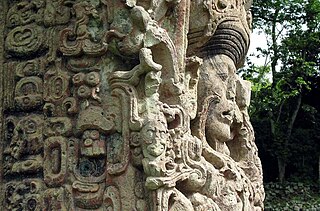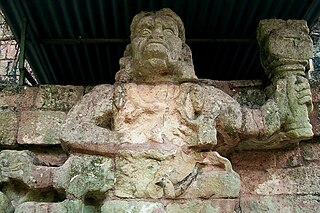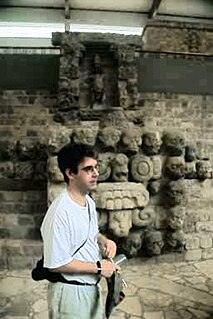
Tikal is the ruin of an ancient city, which was likely to have been called Yax Mutal, found in a rainforest in Guatemala. It is one of the largest archaeological sites and urban centers of the pre-Columbian Maya civilization. It is located in the archaeological region of the Petén Basin in what is now northern Guatemala. Situated in the department of El Petén, the site is part of Guatemala's Tikal National Park and in 1979 it was declared a UNESCO World Heritage Site.

Kʼinich Janaab Pakal I (Mayan pronunciation: [kʼihniʧ xanaːɓ pakal], also known as Pacal, Pacal the Great, 8 Ahau and Sun Shield, was ajaw of the Maya city-state of Palenque in the Late Classic period of pre-Columbian Mesoamerican chronology. He acceded to the throne in July 615 and ruled until his death. During a reign of 68 years, the longest known regnal period in the history of the Americas, the 30th longest worldwide and longest until Frederick III in the 15th century, Pakal was responsible for the construction or extension of some of Palenque's most notable surviving inscriptions and monumental architecture.

Yax Nuun Ahiin I, also known as Curl Snout and Curl Nose, was a 4th-century ruler of the Maya city of Tikal. His name when transcribed is YAX-?-AH:N, translated "First? Crocodile". He took the throne on September 12, 379, and reigned until his death. He is referred to by the Mayan title ajaw, meaning lord.
Siyaj Kʼakʼ, also known as Fire is Born, was a prominent political figure mentioned in the glyphs of Classic Period Maya civilization monuments, principally Tikal, as well as Uaxactun and the city of Copan. Epigraphers originally identified him by the nickname "Smoking Frog", a description of his name glyph, but later deciphered it as Siyaj Kʼakʼ, meaning "Fire is born". He is believed to have been the general of the Teotihuacano ruler Spearthrower Owl.

Kʼinich Ahkal Moʼ Nahb III also known as Chaacal III and Akul Anab III,, was an ajaw of the Maya city of Palenque. He took the throne on 30 December 721, reigning until c.736.

Uaxaclajuun Ubʼaah Kʼawiil, was the 13th ajaw or ruler of the powerful Maya polity associated with the site of Copán in modern Honduras. He ruled from January 2, 695, to May 3, 738.

Chak Tok Ichʼaak I also known as Great Paw, Great Jaguar Paw, and Toh Chak Ichʼak was an ajaw of the Maya city of Tikal. He took the throne on August 7, 360? and reigned until his death in 378, apparently at the hands of invaders from central Mexico.
Yax Pasaj Chan Yopaat, also known as Yax Pasaj Chan Yoaat, Yax Pac and Yax Pasah, was ruler of the Maya kingdom of Xukpi from 763 to 810 or later. This is on the site of the city of Copán in western Honduras. He is the king who made Altar Q.

Sihyaj Chan Kʼawiil II, also known as Storm Sky and Manikin Cleft Sky, was an ajaw of the Maya city of Tikal. He took the throne on November 26, 411 and reigned until his death. He was a son of his predecessor Yax Nuun Ahiin I and Lady Kʼinich, and a grandson of Spearthrower Owl. Stela 31, erected during his reign, describes the death of his grandfather in 439; other monuments associated with Sihyaj Chan Kʼawiil II are Stelae 1 and possibly Stelae 28. Tikal Temple 33 was Sihyaj Chan Kʼawiil II's funerary pyramid and his tomb was located beneath it.

The Margarita Tomb, also known as The Queens tomb, lies buried deep in the center of the Late Classic Acropolis of Copán, Honduras. It is a multi – leveled tomb with one of the largest caches ever found associated with the burial of a Maya woman.

The North Acropolis of the ancient Maya city of Tikal in Guatemala is an architectural complex that served as a royal necropolis and was a centre for funerary activity for over 1300 years. The acropolis is located near the centre of the city and is one of the most studied of Maya architectural complexes. Excavations were carried out from 1957 to 1969 by the University of Pennsylvania, directed by Edwin M. Shook and William Coe.
Kʼinich Popol Hol was a king of the Maya city of Copán. Popol Hol's main achievement was to cement the mythology and institutions of Central Peten kingship at Copan, which lasted 400 years. He was co-ruler with his father for the baktun ending rites of December 9, 435 as shown on the Motmot Marker. He declared himself the son of Yax Kʼukʼ Moʼ on Stela 63 and he claimed succession as the second king of Copan on the Xukpi Stone.
Bʼalam Nahn was the seventh ruler of Copan after the reformation initiated by Kʼinich Yax Kʼukʼ Moʼ. His nicknames were Jaguar Mirror and Waterlily-Jaguar. Bʼalam Nehn was the first king to actually record his position in the dynastic succession, declaring that he was seventh in line from Kʼinich Yax Kʼukʼ Moʼ. Stela 15 records that he was already ruling Copán by AD 504. Bʼalam Nehn is the only king of Copán to be mentioned in a hieroglyphic text from outside of the southeastern Maya region. His name appears in a text on Stela 16 from Caracol, a site in Belize. The stela dates to AD 534 but the text is not well understood. Bʼalam Nehn undertook major construction projects in the Acropolis, building over an early palace with a number of important structures.

Yax Ehb Xook, also known as Yax Moch Xok and Yax Chakte'I Xok, was dynastic founder and ajaw of the Maya city-state of Tikal. He ruled c. 90 AD.

The history of Maya civilization is divided into three principal periods: the Preclassic, Classic and Postclassic periods; these were preceded by the Archaic Period, which saw the first settled villages and early developments in agriculture. Modern scholars regard these periods as arbitrary divisions of chronology of the Maya civilization, rather than indicative of cultural evolution or decadence. Definitions of the start and end dates of period spans can vary by as much as a century, depending on the author. The Preclassic lasted from approximately 2000 BC to approximately 250 AD; this was followed by the Classic, from 250 AD to roughly 950 AD, then by the Postclassic, from 950 AD to the middle of the 16th century. Each period is further subdivided:

Wak Chan Kʼawiil, also known as Double Bird, was an ajaw of the Maya city of Tikal. He took the throne on December 27, 537(?) and reigning probably until his death. He was son of Chak Tok Ichʼaak II and Lady Hand. He sponsored accession of Yajaw Teʼ Kʼinich II, ruler of Caracol in 553. The monument associated with Wak Chan Kʼawiil is Stelae 17.

















